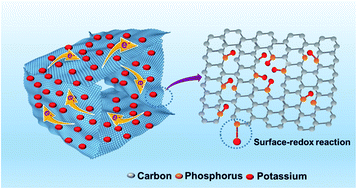Insights into high capacity and ultrastable carbonaceous anodes for potassium-ion storage via a hierarchical heterostructure†
Abstract
Carbonaceous materials are promising anode materials for potassium-ion batteries (PIBs). However, due to the large size of K+ ions, pristine carbon anode materials exhibit poor rate capability and unsatisfactory cycling stability. Herein, a novel anode with a hierarchical porous carbon structure and defects is reported. Integrating the mesoporous structure and P-dopants at the carbon surface not only offers more active sites for K+ adsorption but also enlarges the layer spacing to accommodate stress during potassiation/depotassiation. The as-prepared electrode exhibits ultrahigh stability at a current of 1 A g−1 (over 10 000 cycles without obvious capacity decay) and superior rate capability (165 mA h g−1 at a current density of 10 A g−1), outperforming most of the reported carbonaceous electrodes in PIBs. Through integrated comprehensive experimental characterization and theoretical calculations, the charge storage and transport mechanisms in such a material demonstrate that P doping into the porous structure is beneficial for synergistically improving K+ ion storage and transport by enhancing the adsorption of K+ ions and reducing the diffusion barrier of K+ ions. This work sheds light on how tailored heterostructures could enhance K+ storage and transport and provide new pathways for materials design for ultrastable PIBs.



 Please wait while we load your content...
Please wait while we load your content...